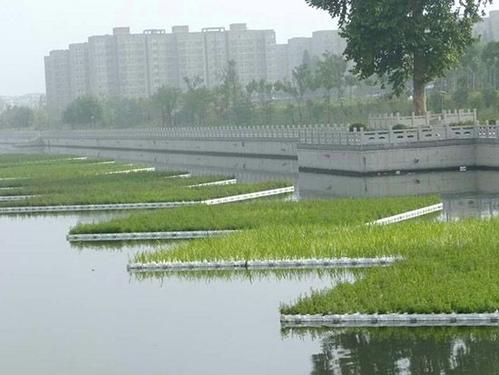Characteristics of Ecological Floating Bed Water Purification System
(1) Absorption, adsorption, and enrichment effects
During the growth process, plants can directly absorb excess nitrogen and phosphorus from polluted water bodies, in order to
To meet the needs of their own growth, plant roots can adsorb and accumulate heavy metals and some toxic and harmful substances, and then achieve the removal of nutrients and heavy metals in water bodies.
(2) Oxygen infusion effect
Plants can release oxygen generated by photosynthesis into the water through their roots, increasing dissolved oxygen content, promoting rapid purification of pollutants, and creating an oxidizing microenvironment in the plant root zone. This environment, which combines aerobic, facultative, and anaerobic zones, provides suitable habitats for aerobic, facultative, and anaerobic microorganisms in the root zone, promoting nitrification, denitrification reactions, and excessive accumulation of phosphorus by microorganisms.
(3) Secreting organic compounds
During the growth period, plant roots can release a lot of organic matter degrading secretions, providing root microorganisms with a lot of nutrients and energy substances, accelerating the decomposition of organic pollutants, and then adding a lot of DO to the water, creating conditions for the proliferation of aerobic microorganisms.

(4) Physical effects
The presence of floating bed plants can reduce water flow velocity. When the polluted water flow expires, harmful substances in the water will be adsorbed and deposited by the root system, creating excellent conditions for the deposition of suspended solids. Moreover, the thriving root system of plants has a huge surface area, which can provide excellent attachment carriers for suspended pollutants and various microorganisms in water.
(5) Algal inhibition effect
Due to their large biomass, long life cycle, and strong ability to absorb and store nutrients, plants have an advantage in competing with planktonic algae for nutrients and light energy, and can effectively control the growth of algae.
Artificial ecological floating bed water purification is an effective in-situ water ecological restoration method, which fully utilizes the synergistic effect of natural purification and various aquatic organisms in aquatic plant systems to purify water quality, fundamentally achieving a dual effect of ecological water purification and landscape beautification.
The article originates from: Natural Ecological Water Purification System http://www.scneng.com.hk
-
06-11
"Environmental Doctor" Du Siyuan: Environmental Protection is a Lifestyle Attitude
There is a Hong Kong compatriot in Jiangmen who often frequents various farms and plantations, walks in mechanical factories, and is seen by others as the nemesis of environmental problems. He conside
-
03-16
Deodorant manufacturer: Deodorants reduce soil pollution
Waste is a chaotic mixture of various components. The accumulation of debris on the surface of soil can cause some chemical reactions, releasing harmful gases, which can lead to soil pollution and eve
-
12-01
Deodorant Manufacturers: Differences between Microbial Deodorants and Traditional Deodorants
The waste that is not needed in our daily life and work is called waste. Due to the large amount of waste discharged and the complex categories, there are great difficulties in reducing waste and deod
-
11-08
Application of Deodorant Manufacturers in Domestic Waste Treatment
Garbage is the waste generated in everyone's daily life and work. Due to its large discharge volume and complex and diverse composition, it poses great difficulties in reducing and deodorizing wa
